
Network of Scientific Journals from Latin America and the Caribbean, Spain and Portugal

Load check on anchored curtains located in geotechnical hazard areas in the city of Rio de Janeiro
Verificação de carga em cortinas ancoradas localizadas em áreas de risco geotécnico na cidade do Rio de Janeiro
Verificación de carga en cortinas ancladas ubicadas en áreas de riesgo geotécnico en la ciudad de Río de Janeiro
Load check on anchored curtains located in geotechnical hazard areas in the city of Rio de Janeiro
Revista de la Asociación Latinoamericana de Control de Calidad, Patología y Recuperación de la Construcción, vol. 8, no. 1, 2018
Asociación Latinoamericana de Control de Calidad, Patología y Recuperación de la Construcción, A. C.
Received: 21 June 2017
Accepted: 07 December 2017
Published: 31 January 2018
Abstract: This article aims to investigate the load behavior on the tie rods of anchored curtain walls built to eliminate geological-geotechnical hazards on hillsides in the city of Rio de Janeiro. Taking into account increases in overload due to the growth in construction uphill of these structures and the end of their service lives, a simulation was conducted using the Plaxis computational system to estimate the loads on the tie rods of 20 anchored curtains after 50 years. Those results were compared with results obtained from residual load verification tests. The comparison shows that although the theoretical simulations indicate increases in loads over 50 years due to the additional overloads, the tie rods tend to lose load, even with increased overloads in the anchored curtains.
Keywords: anchored curtain, overload, durability.
Resumo: Este artigo tem como objetivo verificar o comportamento da carga em tirantes de cortinas ancoradas executadas para eliminação de risco geológico-geotécnico em encostas da cidade do Rio de Janeiro. Considerando o aumento de sobrecarga devido ao crescimento de construções a montante destas estruturas e o término de sua vida útil, realizou-se uma simulação através do sistema computacional Plaxis para estimar a carga em tirantes de 20 cortinas ancoradas após 50 anos executadas e comparou-se com os resultados obtidos por meio de ensaios de verificação residual de carga. Os resultados mostram que, apesar da simulação teórica indicar aumento de carga em 50 anos devido a sobrecarga adicional, os tirantes tendem a perder carga mesmo com acréscimo de sobrecarga nas cortinas ancoradas.
Palavras-chave: cortina ancorada, sobrecarga, durabilidade.
Resumen: Este artículo tiene como objetivo la verificación y comportamiento de carga en tirantes de cortinas ancladas, ejecutadas para eliminar el riesgo geológico-geotécnico en cuestas de la ciudad de Río de Janeiro. Considerando el aumento de sobrecarga debido al crecimiento de construcciones aguas arriba de estas estructuras y el término de su vida útil, se realizó una simulación a través del sistema computacional Plaxis para estimar la carga en tirantes de 20 cortinas ancladas después de 50 años de ejecutadas y se comparó con los resultados obtenidos mediante ensayos de verificación residual de carga. Los resultados muestran que, a pesar de la simulación teórica que indica un aumento de carga en 50 años debido a una sobrecarga adicional, los tirantes tienden a perder carga incluso con un aumento de sobrecarga en las cortinas ancladas.
Palabras clave: cortina anclada, sobrecarga, durabilidad.
INTRODUCTION
The city of Rio de Janeiro, which is known for both the tragedies caused by landslides on its slopes and the terrain formed by the encounter of the ocean with the mountains, has built more than eleven thousand interventions on hillsides located at different sites in the municipality over the past 50 years. Approximately 20% of those constructions were executed on anchored curtains.
This type of hillside containment structure stands out as the most important of those executed in the city over the years, both due to the type’s structural design and its investment and maintenance costs. An anchored curtain is a reinforced concrete structure that has a specific geometry and is comprised of large vertical panels of slabs with reinforcements in the support region (tie rods) and structural steel elements that anchor it to the ground.
On the hillsides of the city of Rio de Janeiro, where most of these containment constructions are located, poor communities grow, and informal residential properties are constructed. Their main characteristic is the absence of adequate technical standards, often without surrounding urbanization and without important public services such as sanitary sewage and household waste collection.
Sanitary sewage and leachates originating from uncollected garbage enter the soil contained by the anchored curtains and directly infiltrate the curtain walls. In many cases, their presence can be perceived as they run down through the drains of the structure.
These reinforced concrete structures are subjected to aggressive attacks by agents in the sanitary sewage originating from informal buildings and leachates from uncollected garbage, both of which cause pathological manifestations that decrease the service lives of these structures.
It is necessary to know, evaluate, and classify the degree of aggressiveness of the environment and to know the concrete and geometry of the structure, thus establishing the correspondence between both, i.e., between the aggressiveness of the environment and the durability of the concrete structure (HELENE, 1983).
Due to the increasing problems of early degradation observed in the structures, new competitive needs, and sustainability requirements in the civil construction sector, in the last two decades there has been a worldwide tendency to focus on design aspects related to durability and the extension of the service life of reinforced and prestressed concrete structures (CLIFTON, 1993).
As prescribed in European Concrete Standard EN 206-1 2007, the design service life for current structures is at least 50 years, which is applicable to reinforced concrete structures with anchored curtains. This indicator is useful to ensure minimum performance levels.
In view of the approaching end of the minimum design service life of approximately 25% of the anchored curtain walls executed on the hillsides of the city, a survey program for those structures was established. A large presence of pathological manifestations was found, indicating that the service lives of the anchored curtains are less than the minimum of 50 years after their execution.
In addition, several of these structures present either losses or increases in work load on their tie rods, the values of which are often different from the loads incorporated at the times of the execution of the structures.
Changes in load through time indicate changes in the distribution of forces along the structural wall of the curtain, which result in increased cracking of the concrete surface and openings for the entry of aggressive agents present in the contained and contaminated soil.
Residual load verification tests on anchored curtain tie rods must be performed every five years to obtain residual load values. Although NBR 5629 2006 (Testing of tie rods anchored to the ground) specifies the procedures for verifying the performance of a tie rod using four tests (basic, qualification, reception and fluency), this test has the same nature as the previous tests, which is to place a load on the tie rod so that it presents a performance compatible with that determined by the design.
Residual load checking tests on tie rods are important for maintaining anchored curtain containment structures and is performed on 15% to 20% of tie rods. However, the distribution of this test, in addition to being random, may increase when the results of the initial tests demonstrate loss of load for tie rods in a certain region of the structures.
In addition to the practical tests used to evaluate the load behaviors of the tie rods over time, theoretical tests of the rods were carried out using the Plaxis computational tool, which allows simulations of increases in overload due to increases in residential and other buildings uphill from the anchored curtain occurring throughout the years. The loads on the tie rods in reinforced concrete structures of the hillside containment structures located in the city of Rio de Janeiro need to be evaluated. This is because increases in overload cause deformations and cracks in the concrete structures, which in turn serve as the main entrances for aggressive agents such as sulfuric acid from sewage uphill, which penetrate the structures through the contained ground.
The objective of this research, which is related to the study of pathological manifestations due to the cracking processes of structures, is to analyze whether increasing loads on the tie rods of the anchored curtain containment structures behave as predicted by computational simulations when taking into account increases in informal properties uphill of those structures.
ANCHORED CURTAIN HILLSIDE CONTAINMENT STRUCTURES IN THE CITY OF RIO DE JANEIRO
The city of Rio de Janeiro is known worldwide for its natural beauty, which is mainly characterized by its particular geomorphology, i.e., the mountain massifs that are covered by Atlantic forest vegetation and located near the ocean.
The main massif is known as the Tijuca massif and is located in regions of the southern and northern zones and downtown area of the city. The Tijuca massif has the highest occupational density. It has been occupied for more than 100 years by people living in informal constructions since the beginning of the first favela in Brazil, which was located on Providência Hill in the downtown area in 1897.
The name favela was first used because the first inhabitants of Providência Hill referred to the place as the "favela hill", which was a reference to a hill of the same name located in Canudos (a municipality in northeast Brazil) that was covered by a low shrub also called "favela". Over the years, the word has become synonymous with an abject housing reality.
The population, which was incapable of moving from the downtown area of the city and from the larger concentration of job offers, looked for other ways to stay in the region, which resulted in the beginning of the first favelas in the city. Urban development and the lack of mobility of the poor population make it essential for them to remain in the central regions, regardless of the housing conditions offered (ABREU, 1988).
High unemployment rates, informal growth, real estate speculation, a lack of housing policies for the low-income population and an unsatisfactory public transportation system are among the reasons for the growth of the favelas in the municipality of Rio de Janeiro.
Data released by the Brazilian Institute of Geography and Statistics (Instituto Brasileiro de Geografia e Estatística - IBGE) Census in 2010 reveal that 20% of the city's population currently lives in slums, which means that 1,393,314 people live in the 763 favelas in the municipality. Of those, approximately one million inhabitants live on slopes located in hazardous areas that present high probabilities of suffering mass movements (landslides, falls, rocks rolling down-slope, and debris flows) involving soil, rock, vegetation and garbage/rubble.
Landslides in the hills of the city of Rio de Janeiro are a cyclical phenomenon that lead to enormous economic and social damage that includes road blockages and the destruction of common types of houses, resulting in homelessness and in many cases loss of life.
Therefore, the prediction of landslides and other geotechnical accidents has been gaining increasing importance in the geomorphological and geotechnical literature on the city. Figure 1 shows landslide susceptibility maps for four communities in the city of Rio de Janeiro.
Several concepts are used to address the landslide problem and its forms of investigation. Most proposed methodologies aim to define areas that are critical to landslides, that is, areas of greater susceptibility for the process to occur.
The term accident refers to an event that has already occurred and for which social and/or economic damage (losses and damages) has been recorded. Hazards, however, represent the possibility or probability of some damage to a population (people, physical structures, and production systems) or to a segment of a population. It is a potential condition under which an accident could occur. (AUGUSTO FILHO et al. 1990a). The implementation of hillside containment structures in poor communities is a response to public policies intended for hazard mitigation on hillsides, urbanization, and improvements in accessibility and mobility for residents. Figure 2 shows the front view of an anchored curtain built in the community of Barro Preto in the district of Méier, Rio de Janeiro.
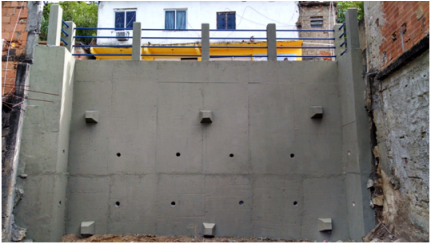
This geotechnical solution constitutes the most adequate technical solution for containing the high horizontal forces resulting from deep excavations with minimum displacements of soil mass and structures located in the vicinity.
The execution of anchored curtains, although old, is among the most modern containment methods. The method employs prestressed rods and anchors to support the terrain. Its primary advantage is its potential application without having to cut anything beyond that necessary. Using this geotechnical solution, it is possible to overcome any height and situation, but there are disadvantages, which include high implementation costs due to its time-consuming execution.
APPLYING THE PLAXIS COMPUTATIONAL TOOL TO THE CASE OF EXISTING CURTAINS
With the development of computers, finite-element numerical modeling has become a powerful and widely used tool for analyzing containment structures in geotechnical environments. This sophisticated tool improves the modeling of containment structures because it allows analyses of their construction sequences and behaviors through time, including the effects of additional overloads on the structures and tie rods anchored to the ground, which are the object of study of the present work. Numerical finite element analyses requiring software aids are widely used to solve structural engineering problems.
According to Lopes (1995), the finite element method (FEM) is the most commonly used numerical method employed in geotechnical civil engineering due to its ease in dealing with heterogeneous, nonlinear (nonlinear elasticity and plasticity) and time dependent (viscosity and densification) problems.
In stress-strain analyses involving soils, Safety Factors (SFs) can be obtained using soil resistance or workload parameters pertinent to the problem under study. SF therefore can be estimated using FEM simulations of service ruptures, which are characterized by soil plastification.
SFs are evaluated as functions of reductions in soil resistance parameters by dividing the actual parameters by their respective estimated values and by then employing those evaluations to calculate the degree to which soil resistance is mobilized. The values of c* and 𝞥* are obtained using
where
c- Soil cohesion;
c* - Cohesion reduced by the SF for use in the simulation;
𝞥 – Soil friction angle;
𝞥* - Soil friction angle as reduced by the SF for use in the simulation; and
M – Value for the reduction of the resistance parameters.
The SF ensures the global stability of the model for soils on the verge of rupturing, i.e., soil plastification. This will occur when SF is equal to M or when the system’s workloads are divided by an estimated value, but in either case, the degree to which the resistance is mobilized is evaluated.
Finite element modeling involves the definition and manipulation of the geometry and specifications of the material and its properties, generation of the finite element mesh, and definition of the loads and displacements that will be applied to the component. A schematic representation is shown in Figure 3.
Four basic procedures are employed for solving geotechnical engineering problems using the finite element method: discretization of the continuous medium, selection of the displacement model, calculation of the stiffness matrix, and calculation of the unknown variables of the problem. In the first phase, the continuous medium or domain of the problem is divided into sub-domains called finite elements that are connected by a finite number of nodal points or, more simply, nodes.
The discretization of the continuous medium occurs when it is divided by imaginary lines and surfaces that result in a finite number of two-dimensional elements that, for this research, was verified to be sufficient for the analysis.
To select the displacement model, a set of polynomial functions is then used, i.e., functions composed of a polynomial that defines the displacement field as a function of the nodal displacements of each element.
The calculation of the stiffness matrix, an interpolation function, allows relating the value of the variable of the problem to be solved in the nodes of each element with its geometry and property, generating a system of equations in matrix form.
The reinforcing bars of a hillside containment structure must absorb the tensile and compressive stresses arising primarily in the vertical parameters of the anchored curtains, which are dimensioned to resist not only bending but also the punching shear in the region of the tie rods.
The calculation model is a two-dimensional geometric model with length and height dimensions. Auxiliary lines are used to simulate the excavation of the structure. The base supports are fixed, and the lateral supports are movable to allow for lateral displacements.
It is recommended, for the good development of the modeling of the curtain, that the conditions of plane state deformation be satisfied. In this case, the axial stiffness (AS) and the bending stiffness (BS) are determined by equations 3, 4 and 5, where is the modulus of elasticity, and t is the thickness of the curtain.
In the curtain anchorage modeling, different elements are observed and divided into free and anchored sections. Between the free section and the ground, the mobilized shear stress is ignored, and spring elements are used to connect the curtain to the anchor bulb.
The anchored section generates three-dimensional stresses on the soil mass and presents \ less satisfactory modeling than that of the curtain because it approaches a plane state of deformation due to the use of two dimensions.
Because the modeling is two-dimensional, soil deformations occurring between the anchor lines perpendicular to the presented model are completely ignored. Care must be observed with issues such as data entry, specification of soil and material parameters, spacing of the tie rods, and the distribution of the forces applied to the tie rods in this measurement.
The anchorage-free section is modeled by an elastoplastic element denominated in Plaxis as the “node-to-node anchor element” because the pre-stress is applied to that element.
The anchoring bulb is modeled using one element per meter having only axial stiffness, which is denominated in Plaxis as a "geogrid". These elements are only subjected to tensile stresses and are thus characterized by the axial stiffness AS.
According to BEIJINHA (2009), the behavior of the curtain can be realistically approximated to a plane strain state, and the anchors are not satisfactorily represented in Plaxis 2D because they generate a three-dimensional state of stresses in the mass of soil.
In the modeling carried out for the 20 anchored curtains, the soil behavior was investigated in relation to the shear strength, its plastification at the time of the execution of the structure, and its projection after 50 years of service life. In Figures 4 and 5, the anchored curtain does not present changes in the plastification points or shear strength of the soil at the structure’s service life of 50 years in the service life of the structure. This is due to the fact that the curtain has three rows of tie rods, which impart a smaller variation on the forces on the soil structure.
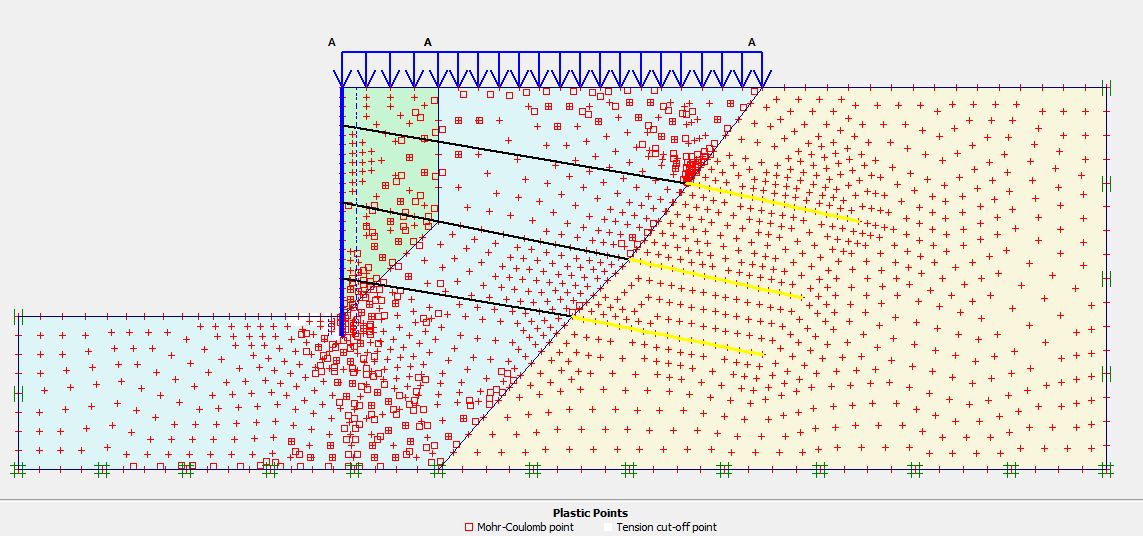
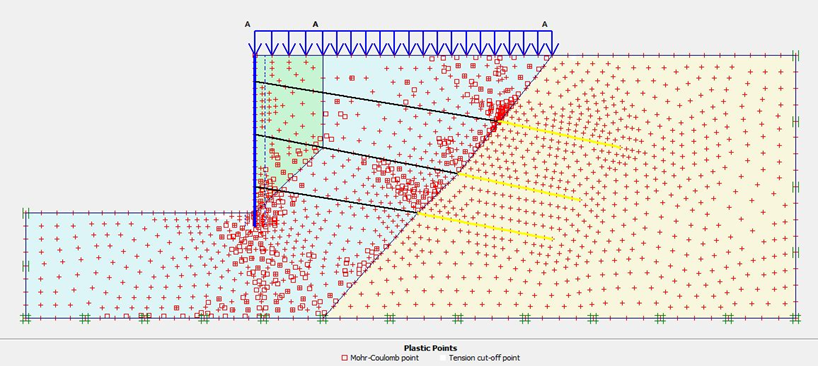
Soil strains or displacements (see Figure 6), which can occur between the anchor lines in the direction normal to the plane of the problem, are ignored in the two-dimensional situation. For that reason, the actual force applied on the rods is divided by the spacings between the rods in the normal direction.
The verification of the plastification points and the shear strength of the soil contained by the anchored curtain over time allows determining whether alterations in soil behavior occur under additional overloads and at the points near the curtain with greatest vulnerability, where the tendency for soil rupture exists.
With increasing overloads over time, a second plastification occurs in the lower part of the panel of the anchored curtain, with a small change in the plastification zones of the contained soil. It has been verified that there is no plastification of the soil in the upper section of the panel.
The region near the support of the curtain and the first row of tie rods, which coincides with the displacement that the curtain undergoes due to the increase in overload over time, and the second row of tie rods, which is a section near the transition between the free section and the anchored section of the tie rod, indicate a stress zone in the soils.
Although the FEM modeling employing the Plaxis 8.2 computational program considers some of the particular characteristics of the soil such as its dilating nature, the determination of the boundary between the plastification and elasticity zones of the soil can be considered as absent.
For analyzing soil behavior in geotechnical problems, one usually implicitly assumes that for regions with elastic behavior, the soil is analyzed using a linear-elastic model that would allow verification of the immediate settlements of a foundation, i.e., the stress distribution related to the strains in the soil.
For the plastified region of the soil, on the other hand, a rigid plastic model with resistance parameters such as cohesion and angle of friction of the soil, which are related to its stability and rupture, would be used. In other words, the amount of soil undergoing a flow process is evaluated.
Therefore, neither the elastic nor plastic behaviors of the soil change with increasing overload over time and although the boundary zone between the two soil behaviors cannot be determined, one concludes that it also does not undergo significant changes.
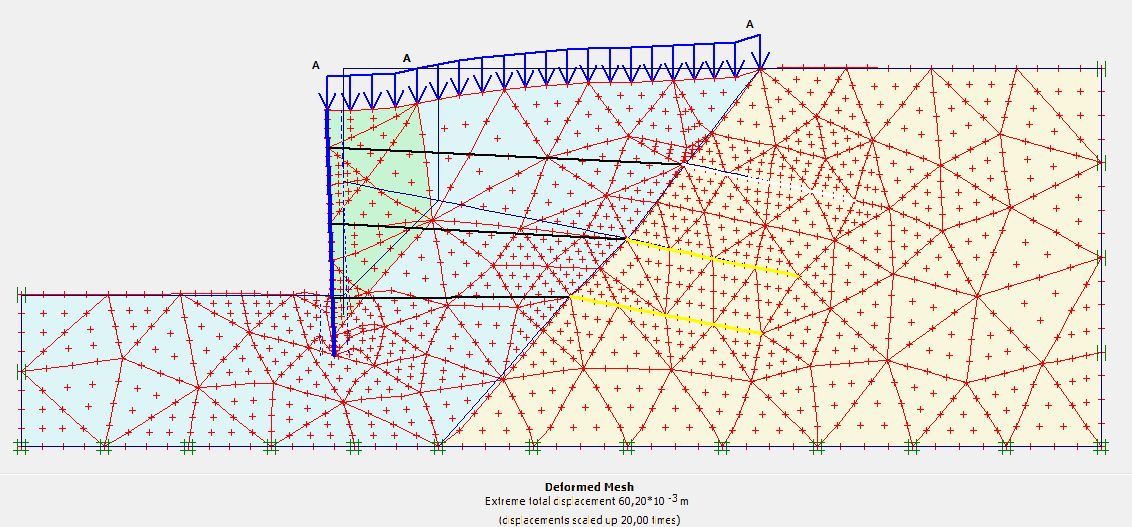
These observations are important in order to know the point at which the added overload results in significant changes in the soil and how that may impact the reinforced concrete panel of the curtain.
The soil tends to settle over time, and the distributions of the grain particles and voids occupied by water are readjusted, which cause the material to consolidate and its resistance to increase.
COMPARISON OF THE THEORETICAL DATA WITH THE PRACTICAL DATA FROM THE LOAD VERIFICATION TESTS
Initially, the analysis of the structural behaviors of the 20 anchored curtains executed in the city of Rio de Janeiro was developed considering the effects of the overload stresses due to the additional forces at the end of the project service life, which was estimated to be 50 years, as established in standard EN 206-1 2007.
Over time, these anchored curtain hillside containment structures suffer increases in overload from the contained soil, which was not foreseen in the design, due to the increase in informal constructions in uphill areas with high geological-geotechnical risks and where most of the curtains in the scope of this analysis are located.
It is known that load change phenomena originally foreseen in the projects can compromise the structural performance and service life of the structure’s design, primarily due to the multiple cracks that a structure with a flat and thin geometry such as an anchored curtain can present in comparison with other reinforced concrete structures such as pillars, beams and more robust slabs.
If they excessively develop over time, these cracks will allow the entry of aggressive agents from the sanitary sewage originating from the informal constructions uphill from the containment structures executed in poor communities, which will attack the reinforcement and concrete structure.
To perform the numerical simulation, the dimensions and rigidity of the curtain, vertical and horizontal spacings, length and load of the tie rods, characteristics of the ground where the bulb and foundation are anchored and other relevant characteristics were used as parameters according to the specification of the design of the hillside containment structures used by the Geotechnical Foundation Institute of Rio de Janeiro (Fundação Instituto de Geotécnica - GEO-RIO).
Therefore, to simplify the model and given the unavailability of survey reports for each executed curtain, the soil behavior was modeled using the Mohr-Coulomb model, which closely represents the behavior of soil in general.
The properties of the materials were input so that the model can be as close as possible to the actual situation for each of the studied cases.
Another important consideration in the case analysis is that it is hard to obtain information regarding the informal properties located uphill from the anchored curtains or their residents, either due to high resident turnover or the construction dynamics of the houses. Thus, an average construction pattern implying an overload of 40 kN/m2 was established. Table 1 presents the geotechnical parameters used in the numerical modeling of the soil layers and earthwork for each anchored curtain.
| Parameter | Symbol | Unit | Backfilling | Layer 1 | Layer 2 |
| Model | - | - | Mohr Coulomb | Mohr Coulomb | Jointed Rock |
| Behavior | - | - | Drained | Drained | Drained |
| Section | - | - | Free | Free | Anchored |
| Dry specific weight | γd | kN/m3 | 17 | 16 | 20 |
| Natural specific weight | γ | kN/m3 | 20 | 18 | 20 |
| Horizontal permeability | Kh | m/day | 1 | 1 | 1 |
| Vertical permeability | Kv | m/day | 1 | 1 | 1 |
| Young's Modulus | E50 | k/Pa | 1.300E+04 | 1.000E+04 | 1.139E+05 |
The material property parameters used for modeling the reinforced concrete curtain are shown in Table 2. They represent the parameters adopted by the GEO-RIO Foundation that are used in modeling specifications for the designs of the anchored curtains.
The homogenization of the material parameters was only possible because the structures, which were built over a span of decades, employed the same technical specifications and executive processes developed by the Design Department of the GEO-RIO Foundation. Therefore, the curtains were designed and constructed in different places on the hillsides of the city of Rio de Janeiro using the same procedures, with changes to their geometric characteristics only.
| Parameters | Symbol | Value | Unit |
| Behavior | - | Elastic | - |
| Normal strength | AS | 2.105 | kN |
| Plane spacing | Ls | 2.00 to 3.50 | m |
| Workload | CT | 160 a 200 | kN |
| Maximum force | Fmax | 1.1015 | kN |
Table 3 presents the workload, plane spacing, and maximum force for the tie rods as adopted by GEO-RIO.
| Parameter | Symbol | Value | Units |
| Behavior | - | Elastic | - |
| Axial stiffness | AS | 12.10612x106 | kN/m |
| Bending stiffness | BS | 0.12x106 | kN m2/m |
| Thickness | d | 0.25 | m |
| Weight | w | 6 | kN/m/m |
| Poison coefficient | ν | 0.15 | - |
After the modeling was performed using the Plaxis 8.2 computer system for 20 curtains anchored with the same executive pattern but with different geometries, the modeling results were compared with the results obtained for the experimental load verification tests with the purpose of observing the loads on the tie rods after the increase in overload over 50 years.
For each anchored curtain, the residual load verification test was performed by randomly sampling up to 20% of the existing tie rods, but at least one rod per line was chosen.
In the last five years, the structural recovery program of the Construction Department of the GEO-RIO performed 229 Residual Load Verification Tests (RLVT) for 20 anchored curtains.
The execution of an RLVT is shown in Figure 7; the test was performed during the structural recovery of the hillside containment structure, which had already accumulated additional overloads over the 50 years since it was built.
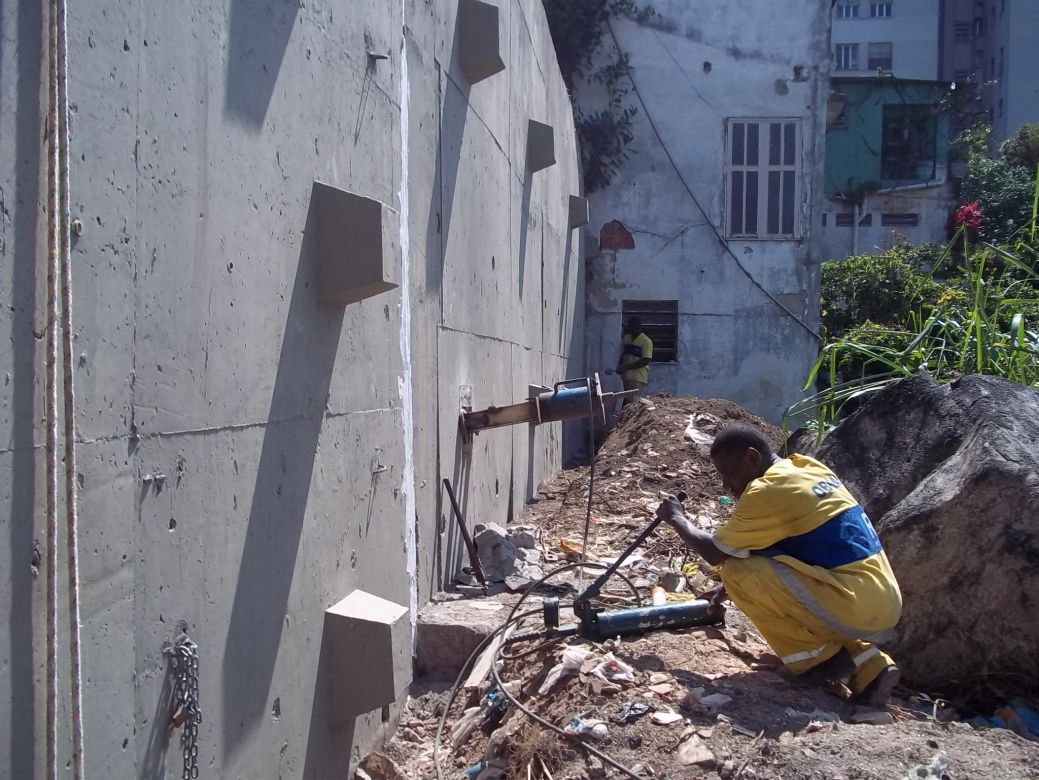
The graph in Figure 8 shows (blue line) the maximum RLVT results for all of the 20 anchored curtains surveyed over a period of 5 years. To obtain conservative values for the residual loads, the maximum residual load in tons for each anchored curtain was considered.
The maximum value of residual load for the tie rods was 22 tons for the curtain located near the Linha Amarela expressway in the suburbs of Rio de Janeiro, and the lowest value of ZERO tons was obtained for the curtain on Mauriti Street in the burrow of Santa Tereza.
The simulated residual loads on the tie rods after 50 years for the same anchored curtains are shown in Figure 8 (blue line). The values of the residual load changed over time from a maximum value of 28 tons for two curtains located in Saint Tereza and in the Tuiuti community to a minimum value of 18 tons for a curtain located in the Coréia community.
Anchored curtains
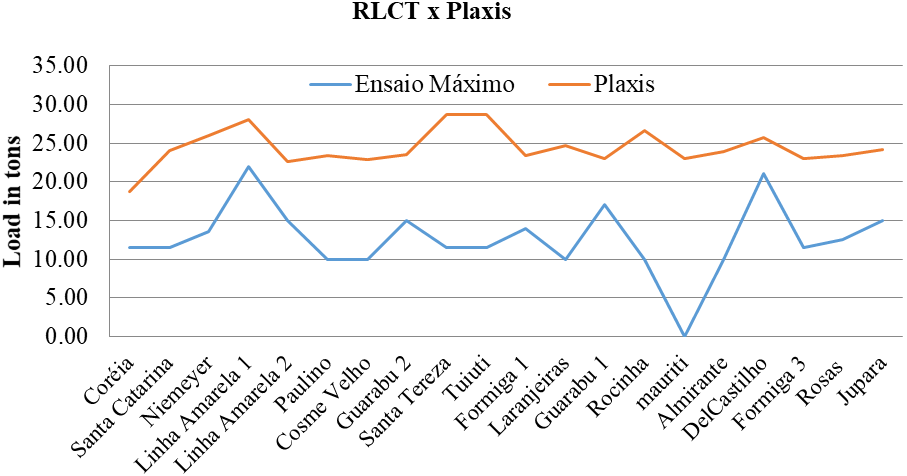
It can be seen that the two lines that represent the tests simulated using the Plaxis computational system (blue line) and residual load verification test (red line) do not meet for any of the 20 anchored curtains surveyed over five years during this research.
CONCLUSIONS
Anchored curtain hillside containment structures are reinforced concrete structures that have estimated service lives of 50 years. They are basically composed of reinforced concrete panels with pile foundations that are anchored to the ground using prestressed steel tie rods and that support the vertical loads of the contained slopes.
The approximately 2,200 structures that have served as the primary solution for geological-geotechnical hazard mitigation in the city of Rio de Janeiro for 50 years since the creation of GEO-RIO require special maintenance attention and interventions to restore and extend their service lives. Considering the uncontrolled growth in informal real estate uphill and surrounding these containment structures, soil contamination by aggressive agents such as sulfuric acid, which is highly corrosive to steel reinforcements, occurs in addition to increased overloads.
After comparing the results of the practical tests and the theoretical tests developed using the Plaxis 8.2 2D computational tool (Figure 8), it was found that the results of the residual load verification tests did not show increases in load over time.
On the other hand, the theoretical tests, i.e., the theoretical load results from the computational model, presented results that were higher than those of the Residual Load Verification Test (RLVT) for the anchored tie rods, indicating that the Plaxis program was unable to perceive their load loss phenomenon over time.
The conclusion is that the Plaxis 8.2 2D computational tool does not consider in its analysis the prestress losses of the tie rods due to the relaxation phenomenon and consolidation of the contained ground over time if compared with the projected future residual loads to which the rods will be subjected after a service life of 50 years.
It is recommended that the developer of the Plaxis 2D geotechnical and structural computational tool review the modeling of anchored curtain structures while considering the temporal development of the loads on the tie rods anchored to the ground due to the increase in overload of the contained slope considered in the proposed model.
It is also concluded that the anchored curtains’ reinforced concrete structures may present during their service lives increases in surface cracks in the concrete due to variations in residual load over time.
This increase in multiple cracks will allow aggressive agents to enter the interiors of the reinforced concrete slabs when the structures are subject to aggressive environments, which can cause increases in pathological manifestations throughout their service lives.
REFERENCES
Abreu, M. (1988), "Evolução Urbana do Rio de janeiro". IPLANRIO. Rio de Janeiro: Ed. Jorge Zahar, 1988.
Amaral, C. P. (1996) "Escorregamentos no Rio de Janeiro: inventário, condicionantes e redu- ção do risco". Tese de Doutorado, Eng. Civil, PUC-Rio.
Andrade, T. (2005), "Tópicos Sobre Durabilidade do Concreto". In: ISAIA, Geraldo Cechella. (Ed) Concreto: Ensino, Pesquisa e Realizações. São Paulo: Editora Ibracon, V1. Cap. 25, p. 753-754, 761,762.
Associação Brasileira de Normas Técnicas (2014), "Projeto de Estruturas de Concreto – Procedimento, NBR – 6118". ABNT, Rio de Janeiro.
Associação Brasileira de Normas Técnicas (2006), "Execução de tirantes ancorados no terreno – NBR 5629". Rio de Janeiro.
Augusto Filho, O., Cerri, L. E. S., Amenomori, C. J. (1990a), "Riscos Geológicos: Aspectos Conceituais". In: Simpósio Latino-Americano Sobre Risco Geológico Urbano, 1, São Paulo, 1990. Anais... São Paulo: ABGE, pp. 334-341.
Bejinha, A. M. D. (2009), "Estruturas de Contenção Ancoradas Sujeitas a Ação Sísmica – Análise de Comportamento". Instituto Superior Técnico – Universidade Técnica de Lisboa.
Brinkgreve, R. B. J. (2002), "Finite Element code for Soil and Rock Analyses – Plaxis – 2D user’s manual". Rotterdam, Netherlands, Balkema.
Brinkgreve, R. B. J. (2017), "Plaxis – 2D manuals". Rotterdam, Netherlands, Balkema.
Censo do IBGE: https://censo2010.ibge.gov.br/materiais.html
Clifton, James R. (1993), "Predicting the Service Life of Concrete". ACI Materials Journal, v. 90, n. 6, p. 611-16.
Durval, R. (1992), "La Durabilité des armatures et du betón d’enrobage". Paris: Pressesde l’École Nationale des Ponts et Chaussées, p. 173-225
European Committee for Standardzation (CEN). "Betão: Parte 1 – Especificação, desempenho, produção e conformidade". EN 206-1, Portugal, 2007.
Farah, F. 2003, "Habitação e Encostas". Coleção Habitare/Finep. São Paulo/SP.
Figueiredo, Enio P., Helene, P. R. L. (1994), "Assim caminha a corrosão". Revista Téchne, v. 2, n. 10, p. 28-33, mai. /jun. 1994.
Georio (2014), "Manual Técnico de Encostas". Volumes 1,2,3 e 4, 2ª edição, Rio de Janeiro.
Helene, P. (1983), "La Agresividad del Medio y la Durabilidad del Hormigón". Asociación Argentina de Tecnología del Hormigón, p.25 – 35.
More, J. Z. P. (2003), "Análise numérica do comportamento de cortinas atirantadas em solos". Dissertação (Mestrado em Engenharia Civil) PUC-RIO.120f
Tschiptschin, A. P. (2011), "Método de Elementos Finitos Aplicado à Seleção de Materiais", USP.
Author notes
alexandrexm2007@gmail.com
Additional information
Cite as:: A. X. Machado, L.
C. Mendes (2018), “Load check on anchored
curtains located in geotechnical hazard areas in the city of Rio de Janeiro”,
Revista ALCONPAT, 8 (1), pp. 64 – 78, DOI: http://dx.doi.org/10.21041/ra.v8i1.200
Legal Information: Revista ALCONPAT is a quarterly publication
of the Latinamerican Association of quality control,
pathology and recovery of construction- International, A. C., Km. 6, antigua carretera a Progreso, Mérida, Yucatán, C.P. 97310, Tel.5219997385893, alconpat.int@gmail.com , Website: www.alconpat.org
Editor: Dr. Pedro Castro Borges. Reservation of rights to exclusive
use No.04-2013-011717330300-203, eISSN 2007-6835,
both awarded by the National Institute of Copyright. Responsible for the latest
update on this number, ALCONPAT Informatics Unit, Ing.
Elizabeth Sabido Maldonado, Km. 6, antigua carretera a Progreso, Mérida, Yucatán, C.P. 97310.
The views expressed by the authors do not
necessarily reflect the views of the publisher.
The total or partial reproduction of the
contents and images of the publication without prior permission from ALCONPAT
International A.C. is not allowed.
Any discussion, including authors reply, will
be published on the third number of 2018 if received before closing the second
number of 2018.